Within the programming international, there are particular forms of bins which are used to retailer information. Those bins are not anything however information buildings. Those bins have other homes related to them, which can be used to retailer, arrange, and manipulate the information saved in them.
On this article, we can be going to introduce you to the several types of information buildings in C together with their implementation.
Forms of Knowledge Constructions in C
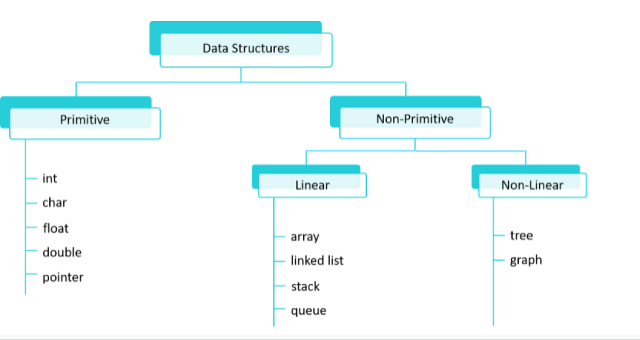
The knowledge buildings in C will also be labeled into two classes:
-
Primitive Knowledge Constructions
The primitive information buildings in C are the ones elementary information buildings which are already explained within the C language. Those information buildings can be utilized to retailer just a unmarried worth. They’re the basis of information manipulation. The primitive information buildings in C (often referred to as primitive information varieties) come with int, char, go with the flow, double, and guidelines.
-
Non-Primitive Knowledge Constructions
The non-primitive information buildings in C are often referred to as the derived information buildings as they’re derived from primitive ones. Numerous values will also be saved the use of the non-primitive information buildings. The knowledge saved will also be manipulated the use of quite a lot of operations like insertion, deletion, looking out, sorting, and many others. The knowledge buildings like arrays, timber, stacks, and plenty of extra come below this class.
The non-primitive information buildings in C can additional be divided into two classes:
1. Linear Knowledge Constructions
Linear information buildings in C retailer the information in a sequential or linear style. The reminiscence location of every part saved will also be accessed sequentially. The weather will not be provide adjacently within the reminiscence, on the other hand, every part is hooked up to the following part come what may. Instance – arrays, connected lists, stacks, and many others.
2. Non-Linear Knowledge Constructions
Non-linear information buildings in C retailer the information in a non-sequential approach. The knowledge is saved in more than one ranges. The implementation of non-linear information buildings is extra complicated than linear information buildings. Instance – graphs, timber.
At the foundation of measurement, the information buildings in C will also be labeled as:
The static nature of information buildings is exhibited within the reminiscence allotted to them. The scale of such information buildings is fastened because the reminiscence is allotted to them all through the bring together time. Then again, the values of the weather saved don’t seem to be static and will also be changed at any time. Instance – Array.
The dynamic information buildings in C are in a position to resizing themselves all through the run time of this system. The reminiscence house allotted to such information buildings will also be changed (higher or diminished), thus offering extra flexibility to govern the information saved in them. Instance – Connected Record.
Array Knowledge Construction in C
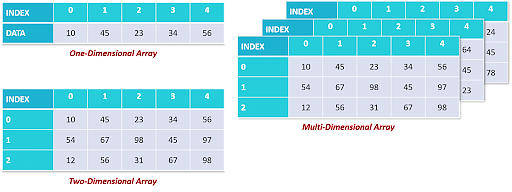
The array information construction in C is a linear information construction that may be described as a gaggle of more than one entities of equivalent kind into a bigger workforce. Those entities or parts will also be of int, go with the flow, char, or double information kind or will also be of user-defined information varieties too like buildings. The array is likely one of the maximum used information buildings in C because it has many sensible in addition to real-life importance.
Allow us to take a real-life instance. Let’s say you need to print 1-100 digits. Now, to retailer them, you’ll be able to do two issues. The primary one is to make 100 variables and retailer the numbers from 1-100 in the ones variables one after the other. The second one approach is to create an array of measurement 100 and retailer the numbers in that array in O(1) time. It’s transparent that the second one approach is extra optimized and sensible than the 1st one as it’s extra handy to retailer those values in one array reasonably than developing 100 variables.
Unmarried dimensional array or 1-D array is the commonest and maximum used type of arrays that may be present in C. 1-D array is composed of parts of equivalent varieties and those parts will also be accessed via their indices.
Additionally Learn: Arrays in Knowledge Construction: A Information With Examples
// pointing out a 1-D array
dataType arrayName [size];
The next instance illustrates the array information construction in C.
#come with <stdio.h>
int major()
{
int i;
// initialize an array.
int my_array[10] = {1, 2, 3, 4, 5, 6, 7, 8, 9};
// enter index the place the part is to be inserted.
int pos;
printf(“Input the location: “);
scanf(“%d”, &pos);
// enter the part to be inserted.
int part;
printf(“Input the part: “);
scanf(“%d”, &part);
if (pos > 10)
{
printf(“Enter is invalid !”);
}
else
{
// proper transferring array parts.
for (i = 9; i >= pos – 1; i–)
my_array[i + 1] = my_array[i];
// insert the part at “pos”.
my_array[pos – 1] = part;
printf(“Array after insertion is:n”);
// print array parts.
for (i = 0; i <= 10; i++)
printf(“% d “, my_array[i]);
}
go back 0;
}
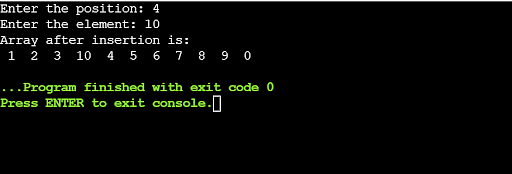
Additionally Learn: What’s C Programming?
Stack Knowledge Construction in C
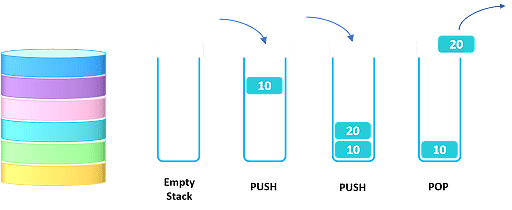
A stack is an information construction that retail outlets the weather in a linear or a sequential approach. The final inserted part within the stack is the only to be got rid of first. That is often known as the final in first out (LIFO) way. To stay a observe of the part inserted within the final, its index is called as the highest. This peak is up to date once a brand new worth is inserted within the stack.
Additionally Learn: Stack Implementation The use of Array in Knowledge Constructions
Syntax
struct stack
{
int myStack[capacity];
int peak;
};
Fundamental Stack Operations
The next are elementary operations which are carried out to govern the information saved in a stack.
- Push (Insertion): The frenzy operation inserts a brand new part on the peak of the stack. The highest is up to date and issues to the newly added part.
- Pop (Deletion): The pop operation deletes the part provide on the peak of the stack. The deleted part is returned through the pop() serve as.
- isEmpty: This operation assessments if the stack is empty or now not. The worth of the highest is typically -1 with regards to an empty stack.
- Peek: The peek operation merely returns the part provide on the peak of the stack.
Stack Implementation The use of Arrays
The next program implements a stack the use of the arrays.
#come with <stdio.h>
#come with <stdlib.h>
#outline capability 15
int rely = 0;
// Stack definition the use of a construction.
struct STACK
{
int myStack[capacity];
int peak;
};
// serve as to create a stack.
void buildStack(struct STACK *stack)
{
stack->peak = -1;
}
// serve as to test if the stack is complete or now not.
// stack complete -> overflow situation.
int isStackFull(struct STACK *stack)
{
if (stack->peak == capability – 1)
go back 1;
else
go back 0;
}
// serve as to test if the stack is empty or now not.
// stack empty -> underflow situation.
int isEmpty(struct STACK *stack)
{
if (stack->peak == -1)
go back 1;
else
go back 0;
}
// serve as to accomplish the frenzy operation within the stack.
void push(struct STACK *stack, int dataValue)
{
if (isStackFull(stack))
{
printf(“Overflow! The stack is complete.”);
}
else
{
stack->peak++;
stack->myStack[stack->top] = dataValue;
}
rely++;
}
// serve as to accomplish the pop operation within the stack
// and go back the deleted worth.
void pop(struct STACK *stack)
{
if (isEmpty(stack))
{
printf(“nUnderflow! The stack is empty. n”);
}
else
{
printf(“The deleted worth is: %dn”, stack->myStack[stack->top]);
stack->top–;
}
count–;
}
// serve as to print the weather of the stack.
void printValues(struct STACK *stack)
{
printf(“The weather of the stack are:n”);
for (int i = 0; i < rely; i++)
{
printf(“%d n”, stack->myStack[i]);
}
}
int major()
{
struct STACK *stack = (struct STACK *)malloc(sizeof(struct STACK));
// create a stack.
buildStack(stack);
// insert information values into the stack.
push(stack, 10);
push(stack, 20);
push(stack, 30);
push(stack, 40);
// print the stack parts.
printValues(stack);
// delete an merchandise on the peak.
pop(stack);
// print the stack parts after acting the pop operation.
printf(“nThe stack parts after the pop operation: n”);
printValues(stack);
printf(“nn”);
}
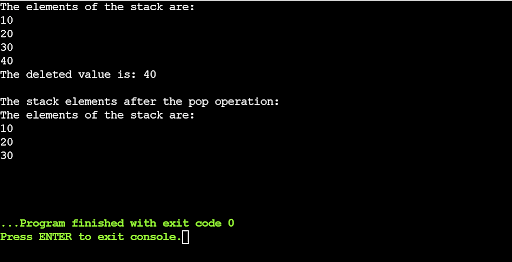
Queue Knowledge Construction in C

A queue is every other information construction that retail outlets the weather in a linear or a sequential approach. The primary inserted part within the queue is the only to be got rid of first. That is often known as the 1st in first out (FIFO) rule. For the reason that parts are inserted at one finish and got rid of from the opposite finish, a observe of the 1st and final indices must be saved. Those are known as the entrance and rear of the queue.
There are lots of examples in genuine lifestyles that resemble the queue information construction in C. Consider a queue of other people ready to talk over with the dentist. The sufferers will likely be served on a primary come first serve foundation. The queue in C is carried out in the similar method.
Syntax
struct Queue {
int myQueue[capacity];
int entrance, rear;
};
Fundamental Queue Operations
The next are elementary operations which are carried out to govern the information saved in a queue.
- Enqueue: This operation inserts a brand new part on the finish of the queue. The rear pointer is up to date when a brand new part is inserted into the queue.
- Dequeue: This operation gets rid of an current part provide on the entrance of the queue. The entrance pointer is up to date when a component is got rid of from the queue.
- isEmpty: The isEmpty operation is to test if the present queue is empty or now not.
- isFull: This serve as is used to decide whether or not the queue has reached its capability or now not.
- Peek: This operation merely returns the part provide on the entrance of the queue.
Queue Implementation The use of Arrays.
The next program implements a queue the use of the arrays.
#come with <stdio.h>
#come with <limits.h>
#come with <stdlib.h>
#outline capability 15
// queue definition the use of a construction.
struct QUEUE
{
int entrance, rear, measurement;
//int capability;
int myQueue[capacity];
};
// serve as to create a queue.
void buildQueue(struct QUEUE *queue)
{
queue->entrance = -1;
queue->rear = -1;
}
// serve as to test if the queue is complete or now not.
int isFull(struct QUEUE *queue)
{
if (queue->entrance == 0 && queue->rear == capability – 1)
go back 1;
else
go back 0;
}
// serve as to test if the queue is empty or now not.
int isEmpty(struct QUEUE *queue)
{
if (queue->entrance == -1)
go back 1;
else
go back 0;
}
// serve as to accomplish the enqueue operation within the queue.
void enqueue(struct QUEUE *queue, int merchandise)
{
if (isFull(queue))
go back;
else
{
if (queue->entrance == -1)
queue->entrance = 0;
queue->rear++;
queue->myQueue[queue->rear] = merchandise;
}
}
// serve as to accomplish the dequeue operation within the queue
// and go back the deleted worth.
void dequeue(struct QUEUE *queue)
{
if (isEmpty(queue))
{
printf(“The queue is empty.n”);
go back;
}
else
{
int deletedValue = queue->myQueue[queue->front];
if (queue->entrance >= queue->rear)
{
queue->entrance = -1;
queue->rear = -1;
}
else
{
queue->entrance++;
}
printf(“The deleted worth is: %dn”, deletedValue);
}
}
void printValues(struct QUEUE *queue)
{
printf(“The weather of the queue are:n”);
for (int i = queue->entrance; i <= queue->rear; i++)
{
printf(“%d n”, queue->myQueue[i]);
}
}
int major()
{
struct QUEUE *queue = (struct QUEUE *)malloc(sizeof(struct QUEUE));
// create a queue.
buildQueue(queue);
enqueue(queue, 100);
enqueue(queue, 200);
enqueue(queue, 300);
enqueue(queue, 400);
// print the queue parts.
printValues(queue);
// delete an merchandise from the queue.
dequeue(queue);
// print the queue parts after acting the dequeue operation.
printf(“nThe queue parts after the queue operation: n”);
printValues(queue);
printf(“nn”);
}
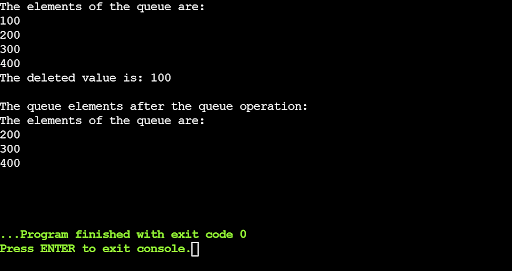
Connected Record Knowledge Construction in C
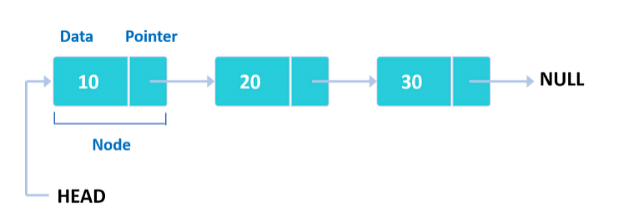
The fourth and final linear information construction on this article is the connected record. In contrast to arrays, parts of a connected record are saved non-contiguously. They may be able to be saved any place within the reminiscence and don’t seem to be attached adjacently. We need to use a pointer to hyperlink the weather in combination.
A connected record is headed through the pointer to the 1st node this is referred to as the top node. The top node or head does now not comprise any worth nevertheless it retail outlets the cope with of the 1st part of the record.
Additionally Learn: Most sensible 7 Sensible Programs of C++ and the Method to Construct a Occupation within the Box
The top will likely be NULL if the connected record is empty.
A node of a connected record is composed of 2 portions:
- Knowledge: Knowledge is the price represented through the node. As an example 1, 2, 0, and so forth.
- Pointer to the following node: This a part of the node accommodates the cope with of the following node.
Syntax
// A connected record node
struct Node {
int information; // information of the node
struct Node* subsequent;
};
Singly Connected Record
The standard connected record is often referred to as the singly connected record. The entirety that we have got mentioned to this point a couple of connected record is appropriate for a singly connected record. Just like the node has two portions, information and the pointer the place the pointer holds the cope with of the following part and so forth. The next instance illustrates the singly connected record in C.
#come with <stdio.h>
#come with <stdlib.h>
struct Node
{
int information;
struct Node *subsequent;
};
// serve as to print the values
// saved within the nodes of the connected record.
void print(struct Node *n)
{
whilst (n != NULL)
{
printf(” %d “, n->information);
n = n->subsequent;
}
}
int major()
{
struct Node *head = NULL;
struct Node *moment = NULL;
struct Node *1/3 = NULL;
// allocate 3 nodes within the reminiscence.
head = (struct Node *)malloc(sizeof(struct Node));
moment = (struct Node *)malloc(sizeof(struct Node));
1/3 = (struct Node *)malloc(sizeof(struct Node));
head->information = 1; // assign information within the first node
head->subsequent = moment; // retailer the cope with of the second one node
second->information = 2; // assign information to the second one node
second->subsequent = 1/3; // retailer the the cope with of the 1/3 node
third->information = 3; // assign information to the 1/3 node
third->subsequent = NULL; // finish the record
// print the connected record.
printf(“The Singly Connected Record is: “);
print(head);
go back 0;
}

Tree Knowledge Construction in C
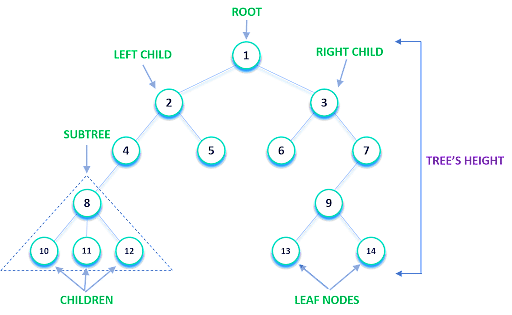
A tree is a dynamic information construction in C that represents the hierarchical connection of nodes.
Let’s speak about one of the vital most well liked and vital timber.
A tree during which every node could have 2 kids at most is referred to as a Binary Tree. The kid node at the left facet of the mum or dad node is referred to as the left youngster while the kid node at the proper facet of the mum or dad node is referred to as the proper youngster of the node.
A node in a Binary Tree basically is composed of 3 portions: information of the node, a pointer to the left youngster, and a pointer to the proper youngster. In C, a construction is used to constitute the nodes of a Binary tree. Believe the next snippet.
struct node
{
int information; // information of the node
struct node* left; // pointer to the left youngster
struct node* proper; // pointer to the proper youngster
};
Right here, information is the price of the node while left and proper are the tips that could the left youngster and proper youngster respectively.
#come with <stdio.h>
#come with <stdlib.h>
struct node
{
int information; // information of the node
struct node *left; // pointer to the left
struct node *proper; // pointer to the proper
};
// Inorder traversal
// 1. left youngster
// 2. root node
// 3. proper youngster
void inorderTraversal(struct node *root)
{
if (root == NULL)
go back;
inorderTraversal(root->left);
printf(“%d ->”, root->information);
inorderTraversal(root->proper);
}
// Preorder traversal
// 1. root node
// 2. left youngster
// 3. proper youngster
void preorderTraversal(struct node *root)
{
if (root == NULL)
go back;
printf(“%d ->”, root->information);
preorderTraversal(root->left);
preorderTraversal(root->proper);
}
// Postorder traversal
// 1. left youngster
// 2. proper youngster
// 3. root node
void postorderTraversal(struct node *root)
{
if (root == NULL)
go back;
postorderTraversal(root->left);
postorderTraversal(root->proper);
printf(“%d ->”, root->information);
}
// Create a brand new Node.
struct node *createNode(worth)
{
struct node *newNode = malloc(sizeof(struct node));
newNode->information = worth;
newNode->left = NULL;
newNode->proper = NULL;
go back newNode;
}
// Insert at the left of the node.
struct node *insertLeft(struct node *root, int worth)
{
root->left = createNode(worth);
go back root->left;
}
// Insert at the proper of the node.
struct node *insertRight(struct node *root, int worth)
{
root->proper = createNode(worth);
go back root->proper;
}
int major()
{
// create a root node
struct node *root = createNode(1);
// insert new nodes to the tree
insertLeft(root, 2);
insertRight(root, 3);
insertLeft(root->left, 4);
printf(“Inorder traversal n”);
inorderTraversal(root);
printf(“nPreorder traversal n”);
preorderTraversal(root);
printf(“Postorder traversal n”);
postorderTraversal(root);
}
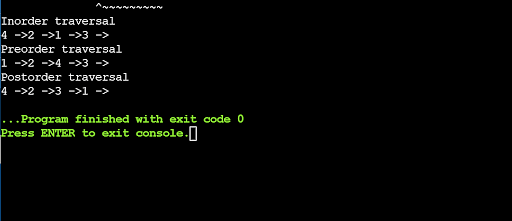
A Binary Seek Tree or BST is an optimized model of a Binary Tree. Like a binary tree, a node of a BST too can have 2 kids at maximum. The main distinction between a Binary tree and a BST is the order during which the nodes are organized. The nodes of a Binary tree don’t apply any order whilst the next order is adopted through the nodes of a BST.
The worth of the left youngster of a mum or dad node must have much less worth than the mum or dad node.
The worth of the proper youngster of a mum or dad node must have a better worth than the mum or dad node.
The left and the proper subtree of a node will have to even be binary seek timber.
Additionally Learn: An Creation to Tree in Knowledge Construction
Graph Knowledge Construction in C
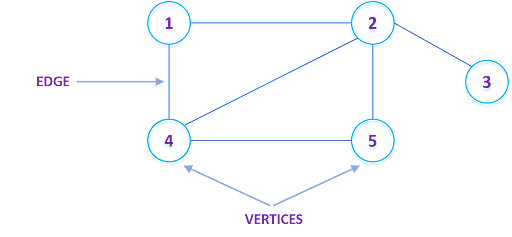
The graph information construction in C is a dynamic and non-linear information construction that is composed of vertices and a few edges that attach the ones vertices. Those vertices are not anything however the nodes. Two nodes are mentioned to be neighboring nodes if there’s an edge that connects each the nodes with every different.
Additionally Learn: Your One-Prevent Resolution For Graphs In Knowledge Constructions
The 2 following graph representations are maximum recurrently used.
Adjacency Matrix
An adjacency matrix is a 2-D sq. matrix i.e., of measurement V x V the place V is the collection of vertices of the graph. An adjacency matrix is represented simply as a standard 2-D matrix and could also be used for weighted graphs. If you happen to see adj[i][j] = 1 the place adj is the identify of the matrix, then it way that there’s one edge between vertex “i” and vertex “j”.
Adjacency Record
An adjacency record is equal to an array. The scale of the array represents the overall collection of vertices of the graph. It’s also used to constitute the weighted graphs the place a listing of pairs represents the weights of the sides.
The next instance illustrates the Graph information construction in C.
#come with <stdio.h>
#come with <stdlib.h>
// construction to constitute an adjacency record node.
struct AdjListNode
{
int dest; // information of the node
struct AdjListNode *subsequent; // pointer to the following node
};
// construction to constitute an adjacency record.
struct AdjList
{
struct AdjListNode *head;
};
struct Graph
{
int V;
struct AdjList *array;
};
// serve as to create a brand new adjacency record node.
struct AdjListNode *newAdjListNode(int dest)
{
struct AdjListNode *newNode =
(struct AdjListNode *)malloc(sizeof(struct AdjListNode));
newNode->dest = dest;
newNode->subsequent = NULL;
go back newNode;
}
// serve as that creates a graph having V vertices.
struct Graph *createGraph(int V)
{
struct Graph *graph =
(struct Graph *)malloc(sizeof(struct Graph));
graph->V = V;
// Create an array of
// adjacency lists of measurement V.
graph->array =
(struct AdjList *)malloc(V * sizeof(struct AdjList));
// initialize every adjacency record
// as empty through making head as NULL
int i;
for (i = 0; i < V; ++i)
graph->array[i].head = NULL;
go back graph;
}
// provides an edge to an undirected graph.
void addEdge(struct Graph *graph, int src, int dest)
{
// upload an edge from supply to vacation spot.
struct AdjListNode *newNode = newAdjListNode(dest);
newNode->subsequent = graph->array[src].head;
graph->array[src].head = newNode;
// upload an edge from vacation spot to supply.
newNode = newAdjListNode(src);
newNode->subsequent = graph->array[dest].head;
graph->array[dest].head = newNode;
}
// serve as to print the adjacency record.
void printGraph(struct Graph *graph)
{
int i;
for (i = 0; i < graph->V; ++i)
{
struct AdjListNode *pCrawl = graph->array[i].head;
printf(“n Adjacency record of vertex %dn head “, i);
whilst (pCrawl)
{
printf(“-> %d”, pCrawl->dest);
pCrawl = pCrawl->subsequent;
}
printf(“n”);
}
}
int major()
{
int V = 5;
struct Graph *graph = createGraph(V);
addEdge(graph, 0, 1);
addEdge(graph, 0, 4);
addEdge(graph, 1, 2);
addEdge(graph, 1, 3);
addEdge(graph, 1, 4);
addEdge(graph, 2, 3);
addEdge(graph, 3, 4);
// print the adjacency record.
printGraph(graph);
go back 0;
}
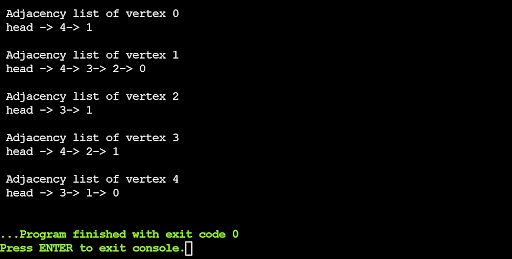
Knowledge Construction in C Comparability
This desk supplies a complete comparability of the six information buildings, highlighting their definitions, traits, implementations, not unusual operations, and standard use instances.
|
Side |
Array |
Stack |
Queue |
Connected Record |
Tree |
Graph |
|
Definition |
Selection of parts known through index, saved in contiguous reminiscence places. |
Linear information construction following LIFO theory. |
Linear information construction following FIFO theory. |
Selection of nodes, the place every node accommodates information and a connection with the following node. |
Hierarchical information construction with a root and sub-nodes (kids). |
Selection of nodes attached through edges, representing relationships between pairs. |
|
Traits |
– Mounted measurement<br>- Homogeneous parts<br>- Random get admission to through index |
– Components added/got rid of from peak<br>- No random get admission to |
– Components added to rear, got rid of from entrance<br>- No random get admission to |
– Dynamic measurement<br>- Environment friendly insertions/deletions<br>- Sequential get admission to |
– Hierarchical<br>- Guardian-child relationships<br>- Quite a lot of varieties (binary, AVL, and many others.) |
– Non-linear<br>- Directed/undirected<br>- Weighted/unweighted |
|
Implementation |
– Declared with a set measurement<br>- Static allocation |
– The use of arrays or connected lists<br>- Dynamic allocation (connected record) |
– The use of arrays or connected lists<br>- Dynamic allocation (connected record) |
– The use of nodes with guidelines<br>- Dynamic allocation |
– The use of nodes with guidelines<br>- Binary tree, AVL tree, and many others. |
– Adjacency matrix or adjacency record |
|
Commonplace Operations |
– Get admission to: O(1)<br>- Insertion: O(1) (finish), O(n) (center)<br>- Deletion: O(1) (finish), O(n) (center)<br>- Traversal: O(n) |
– Push: O(1)<br>- Pop: O(1)<br>- Peek: O(1) |
– Enqueue: O(1)<br>- Dequeue: O(1)<br>- Entrance: O(1)<br>- Rear: O(1) |
– Get admission to: O(n)<br>- Insertion: O(1)<br>- Deletion: O(1)<br>- Traversal: O(n) |
– Insertion: O(log n)<br>- Deletion: O(log n)<br>- Traversal: O(n)<br>- Seek: O(log n) |
– Upload vertex: O(1)<br>- Upload edge: O(1) or O(V)<br>- Take away vertex/edge: O(V)<br>- Traversal (BFS/DFS): O(V + E) |
|
Use Instances |
– Storing collections with recognized measurement<br>- Environment friendly random get admission to through index |
– Serve as name control<br>- Expression analysis (postfix/prefix)<br>- Undo mechanisms |
– Process scheduling<br>- Printer queue<br>- Asynchronous information switch |
– Dynamic reminiscence allocation<br>- Imposing stacks and queues<br>- Navigating directories |
– Hierarchical information illustration<br>- Binary seek timber<br>- Resolution making (recreation timber) |
– Community illustration<br>- Social networks<br>- Pathfinding algorithms (Dijkstra, A*) |
Wrapping Up!
To sum up, on this complete information on information buildings in C, you discovered the number of information buildings that you’ll be able to create the use of the C programming language. You began with a temporary creation to information buildings in C and mentioned the forms of information buildings and operations that may be carried out on them.
Why prevent right here? You’ll be informed extra such attention-grabbing device construction ideas in Simplilearn’s Complete Stack Developer – MERN Stack path. This path will assist you to to construct occupation as a MERN stack developer. You’ll be informed peak talents equivalent to MongoDB, Specific.js, React, and Node.js (“MERN”), plus GIT, HTML, CSS, and JavaScript to construct and deploy interactive programs and services and products.
In case you are a prepared learner and need to stay your self up to date with new applied sciences, take a look at Simplilearn’s whole record of loose on-line classes.
When you’ve got any queries on this “Knowledge Constructions in C” article or tips for us, please point out them within the remark field and our mavens resolution them for you once conceivable.
Satisfied Studying!
FAQs
1. What are the fundamental information buildings in C, and the way are they used?
The fundamental information buildings in C come with arrays, stacks, queues, connected lists, timber, and graphs. Arrays retailer parts of the similar kind in contiguous reminiscence, enabling rapid indexing. Stacks use a last-in, first-out (LIFO) theory, which is beneficial in serve as name control. Queues apply a first-in, first-out (FIFO) theory, splendid for process scheduling.
2. How is a connected record other from an array in C?
Connected lists include nodes with information and tips that could the following node, permitting dynamic reminiscence allocation and environment friendly insertions/deletions. Arrays have variable, fastened sizes and retailer parts, offering rapid indexing however much less versatile reminiscence control. Connected lists are preferable when the dataset measurement is unknown or continuously adjustments. Arrays are higher for static, listed information garage.
3. What’s a stack information construction, and the place is it used?
A stack is a linear information construction that follows the last-in, first-out (LIFO) theory. Components are added (driven) and got rid of (popped) from the highest. Stacks set up serve as calls, expression analysis, and undo mechanisms. They may be able to be carried out the use of arrays or connected lists.
4. How do timber and graphs range in C?
Bushes are hierarchical information buildings with a root and youngster nodes, the place every youngster has just one mum or dad, steadily used for hierarchical information illustration. Graphs are collections of nodes attached through edges, representing extra complicated relationships without a strict parent-child construction. Bushes are utilized in decision-making processes, whilst graphs are utilized in community illustration and pathfinding algorithms.
5. What are the average operations on a queue information construction in C?
Commonplace operations on a queue come with enqueue (including a component to the rear), dequeue (taking away a component from the entrance), entrance (having access to the 1st part), and rear (having access to the final part). Queues apply the first-in, first-out (FIFO) theory. They’re useful in situations like process scheduling and managing print jobs.
supply: www.simplilearn.com












